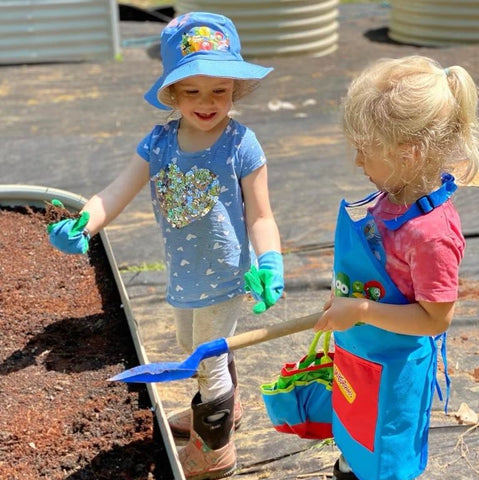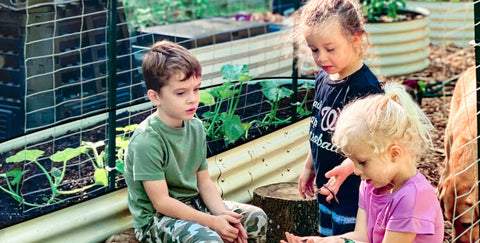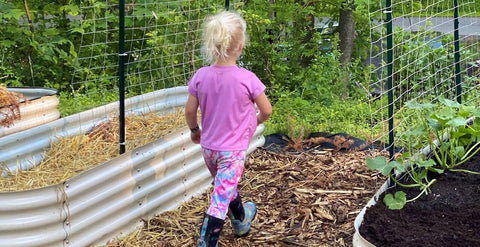Tips from Olle Garden Bed To Get Your Kids Gardening Outside
Gardening with children is so interesting! Some of my favorite childhood memories involve gardening with my grandparents. Tasting fresh chives and carrots from the garden bed really inspired my garden today. Most children can get something from gardening, and tasting fresh produce is a good way to get them involved in the process. You may already know the benefits of spending time in the yard and away from the sofa, including benefits for the immune system and mental space. But how can we help our children enter gardening - an activity that can last into adulthood and benefit them for life? There are many ways to do this, and Olle Garden introduce some of them here.
We've looked at hydroponics for kids, but let's discuss some strategies to spark a general interest in gardening in kids. By involving them, you're helping them understand seasonal cycles, and the seemingly miracle of growing a plant from a seed. Maybe you'll help them develop memories and green thumbs that last a lifetime!

What is their inspiration?
This is one of the easiest and most successful ways to get kids into the garden, even at an early age. Start by asking what they want to grow. Help them feel like they have a say in their gardening experience by giving them the choice to grow their favorite plants. If they like blueberry pie, teach them how to grow blueberries. If they like french fries, show them how to grow potatoes.
Or try gardening with the kids and grow a pizza garden with cherry tomatoes and herbs like basil, oregano, sage and garlic. Coming up with the idea of a food-centric garden will not only pique their interest in tasty snacks here and there, but it will also give them a better understanding of the big picture of gardening, especially when it comes to companion planting.
Now that your kids are motivated to garden, you're giving them one of the best gifts anyone can give. You're also bringing them closer to understanding how food gets from point A (the seeds) to point B (the time to pick the vegetables). If they are passionate about environmental awareness and want to learn the principles of organic gardening, that's another avenue you can follow.
Maybe your child is more interested in planting and growing flowers than food crops and herbs. Maybe they want to grow several different types of cut and re-emerging blooms. Or maybe your child likes a certain habitat, and plants that fit the ecology of that environment. It's entirely possible to grow flowers or cacti, or even jungle understory, with your kids. If you need inspiration, try heading to the nearest botanical garden to lure it in. Some even have children's gardens on-site to help you decide what works best for your situation.

Give them the tools they need to grow
An important factor in holding your child responsible for plants is determining the amount of space dedicated to that purpose. The type of space is also important. Outdoor spaces or outdoor loft beds are just as instructive as indoor spaces. We have a great article on indoor gardening for beginners that translates well to gardening with kids. You can give them their own window space and their own pots to grow their garden of choice.
Maybe you live in an area with a mature garden, or an apartment or condo where the biggest space is the balcony. Less space isn't an obstacle, and showing your kids how to maximize a container garden within these parameters is another great lesson for them.
Or maybe you want to start gardening with your kids by asking your kids to pick a plant at a local nursery to see how it pairs well with a single plant, rather than a garden bed or balcony garden. You can even create a kid's garden in your backyard that your kids and their friends can enjoy.
What if your child wants to grow flowers from seeds, or if they want to bring home some of the flowers they saw at the nursery? By giving them agency when they have something in the garden, you allow them to be the protagonists of their own adventures—and a healthy one.
Another really fun part of putting your kids in charge of creating and maintaining their own garden and learning how plants grow is giving them tools designed for people their size. Grab some gardening gloves for young gardeners. Give them a shovel, trowel and watering can designed for them. If they are interested in soil, or if they have a budding interest in soil science, give them their own little compost pile or worm bag to keep next to you. When mowing, have them add grass clippings and organic materials such as kitchen scraps. They will learn about the process of building soil, and the elements that make up compost.
It's about giving them their own space, and their own tools to build a great garden. Depending on their age and motor skills, you can help them or let them do things on their own!

Inspiring and fun gardening activities
There are so many ways to make gardening fun, and gardening with kids is no exception! Here are some fun ideas, as well as some great tips for gardening with kids, to get your kids interested in developing their own garden space.
Growing plants from seeds
One way to get kids gardening is to help with sowing. Let them see what happens a few weeks after the seeds germinate. A basic method is to put the lima beans in a damp paper towel and then put them in a plastic bag. Once it starts to grow, you can move it to a starter pot and then your garden. Or try rooting seed potatoes. Place the potatoes in a clear water glass and secure with four toothpicks to the sides of the glass. Place the glass in an area that receives sunlight for about 6 hours of the day. You and your kids can watch the roots grow and then plant potatoes when they are fully rooted.
Another simple plant that is fun to sprout from seed is the chia seed plant. Soak the seeds for a day, then spread them on the clay. Then watch as each tiny chia seed sprouts, forming a small plant. Of course, direct garden sows are also instructive.
You can spend as much time teaching them how plants work and the benefits of having them in your garden. They are learning a great hobby while learning about plant growth.
Make it a game
If there's one thing kids love, it's games. It's a good idea to have a friendly rivalry between you and your kids or siblings. Inserting games into gardening projects can take them from fun to so much fun. Choose a plant that produces something easy to measure, such as peppers, tomatoes, or other vegetables. Provide them with the supplies they need and help them produce the largest vegetable possible. Offer rewards to winners. It might be as simple as going to buy ice cream or their favorite snack. You can also incentivize garden maintenance tasks this way. Whoever has the fewest weeds in the garden wins a prize.
If you want to avoid competition, try to reward everyone for sticking with gardening tasks.
Small victories and accomplishments along the way keep them interested, as the process of growing plants is sometimes much slower than the fast-paced world we live in. Feel free to add a personal touch to these matches and make it a family affair. Gardening with kids is also a fun game for adults.
Garden planning and scheduling
Routines are very important to many people, and kids are no exception. If they know that part of their morning routine includes going out to water the plants, or even just checking them, it will become a normal part of their day. They may even look forward to waking up in the morning and Spending time in the garden.
Make sure you show excitement and enthusiasm when you develop a routine with your child. Even the most enthusiastic gardener can find certain tasks a little drudgery. Showing them how the routine pays off is a great opportunity for them to see ongoing efforts progress. Daily walks in the yard to water plants, check plant growth, and even look for garden visitors such as birds, cool bugs, and wildlife will add a fun part to a child's schedule. Soon, they will be looking forward to spending quality time with the plant and its parents.
They might even know about routines that happen in the wild. Kids love watching birds at the bird feeder or bird bath! They also love seeing the garden grow.

One way to make planning and gardening ideas fun for the whole family is to use visual aids. A calendar or garden planner is important to any gardener, and children of visual learners will especially benefit from viewing their tasks and plans in a physical format. Sorting seed packs as a semi-annual event can inject even more excitement into the upcoming season. Incorporating color-coding and fun stickers in vegetable garden layouts to indicate planting times or maintenance activities is sure to keep your kids involved in planning and scheduling. If using a paper planner isn't the best option, try a planner app.
The most important skill to learn from planning and scheduling is understanding the growing season, and the time involved in seasonal work. Knowing when the growing season begins and ends, and how to plan a garden plot within these parameters, can be a fun challenge for children and adults alike.
Gardening is fun!
Remember, kids activities in the garden are explosive! If you don't like it, neither will they. Try not to force your child to do this. Instead, help your child lead by example. We want to build interests and routines and help them discover a new hobby that will improve their self-esteem and life overall. You can spend quality time with them and learn more about their thinking and development. In turn, you will learn more about yourself. Understanding the rewards of responsibility and hard work is another benefit. All while spending time outdoors with their loved ones!
Make sure your kids love their jobs, teach them new skills, and you're setting them up for future success. Involve them in the process of growing tomato plants and snow peas and harvesting them. Let them taste the difference between store-bought produce and homegrown produce. This way, they can develop further interest in growing their own healthy plants.
One of the most important parts of gardening is learning from your mistakes. When this happens to your child (it will) meet these challenges with enthusiasm and understanding, it’s impossible to do it right the first time every time.
Teaching your child to approach obstacles and challenges with curiosity will help them translate this skill into other areas of life - and other plants! This will give them room to create their own great ideas.
